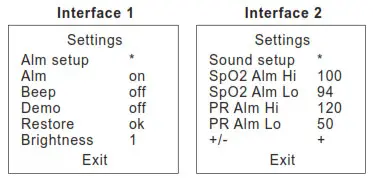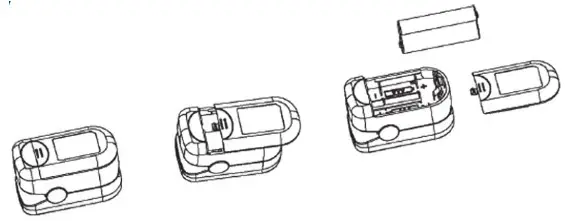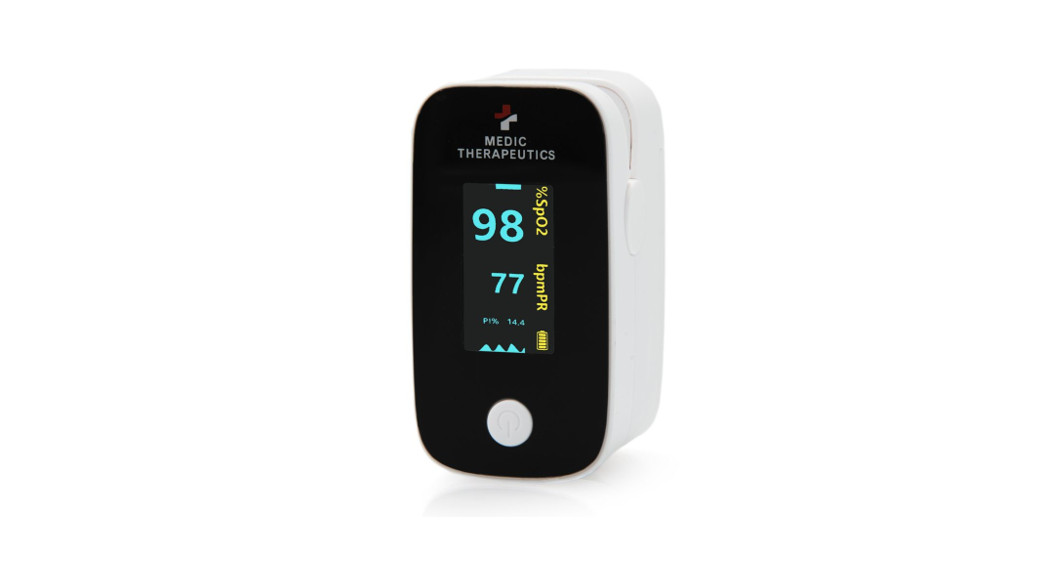
FINGERTIP BLOOD PULSE OXIMETEROperating Instructions – Product Model: YM201
SAFETY PRECAUTIONS
- Do not attempt to repair. Should damage occur, contact the manufacturer directly.
- For best results, periodically change the oximeter position and switch the finger.
- Not for use on newborn babies.
- Seek medical assistance if the reading exceeds the normal reading range and you are certain the device has not malfunctioned.
- To avoid harm, do not expose eyes to the light-emitting components.The following may disrupt the accuracy of the Oximeter:
- Use in a high-frequency environment or around CT machines.
- Used on the same area as a blood pressure cuff, arterial duct, or intravenous injection.
- User suffers from hyper-tension, severe vascular atrophy, severe anemia, or low oxygen.
- User is in sudden cardiac arrest or state of shock.
- Use on a finger with nail polish or fake nails.
WARNINGS
Do not use around a flame or any flammable agents.
- Choking hazard.
- Keep away from children.
- Do not discard batteries in a fire.
- Do not attempt to charge device batteries. Charging can result in battery leakage, fire, or explosion.
- Always discard batteries according to environmental safety guidelines.
- Do not use around MRI, CT, or other X-Ray machines.
- Do not operate if wet.
- Avoid moving device between hot, cold, or humid temperatures.
- Install batteries properly. Remove batteries if being stored for a long period of time.
- Always close the battery cover properly.
- Operate only as directed.
- Do not modify or use for any reason other than the intended purpose.
- Only certified doctors are qualified to evaluate and use the produced results.
PRODUCT ACCESSORIES
- One user’s manual.SYMBOL CONVENTIONS
Symbol Description 
Type BF applied part 
Caution: Please see this manual %SpO2 Symbol of oxygen saturation bpmPR Symbol of pulse rate 
No SpO2 alarms 
Consult the instructions for use IP22 The degree of protection against harmful ingress of water and particulate matter 
When end users abandon this product, they must send the product to the collection place for recycling.
OVERVIEW
Oxygen saturation is the percentage of oxyhemoglobin (HbO2) that is combined with oxygen against all combinable hemoglobin (Hb). It is an important physiological parameter involved in respiration and circulation. The oxygen saturation of arterial blood in a normal human body is 98%. Oxygen saturation is an important indicator of the oxygen condition in the human body. In general, the normal values of oxygen saturation shall not be lower than 94%. If the measured value of oxygen saturation is lower than 94%, an insufficient supply of oxygen is considered. The pulse rate is the number of pulse beats per minute. Normally, the pulse rate is consistent with the heart rate. In general, the pulse rate of every people is 60 to 90 beats per minute.
WORKING PRINCIPLES, EXPECTED USAGE, AND APPLICABLE SCOPE
Based on full digital technology, the Finger Pulse Oximeter non-invasively measures the actual content (oxygen saturation) of oxyhemoglobin (HbO2) in arterial blood using the optical transmittance method. The Finger Pulse Oximeter measures the blood oxygen saturation and pulse rate of a human body via finger artery. It is applicable to a wide range of fields, such as families, hospitals (including operation rooms of the departments of internal medicine and surgery, the department of anesthesiology, the department of paediatrics, and intensive care rooms), oxygen bars, social medical care institutions, and sports & health. Use this instrument for measurement before or after sports. You are not advised to use this instrument during sports activities. Do not use it for continuous care for patients.
APPEARANCE OF THE STRUCTURE

SCREEN DISPLAY

After powering on the Oximeter, hold the power-on Button/functional button for about one second. The Oximeter shows a parameter setting interface. Press or hold the power-on/functional button to perform corresponding operations. Hold it to set an item, or press it to switch an option or switch the display mode. Press means no more than 0.5 seconds, while Hold means more than 0.5 seconds.
ALERT SOUND SETTING
Hold the power-on button/functional button while the Oximeter is in powered-on state. Parameter setting interface 1 is displayed, as shown in the following figure. Move “*” to the corresponding option, and hold the functional button to set “Sound Reminder” to on and set Beep to off. When “Sound Reminder” is set to on and the measured values of the blood oxygen saturation and pulse rate go beyond the upper limit or lower limit, the Oximeter gives off an alert sound. When “Sound Reminder”is set to off and the measured values go beyond the limit, the Oximeter will not give any alert sound. When Beep is set to on, a tick will be heard along with pulse beats during pulse rate measurement. When Beep is set to off, no sound will be output along with pulse beats during pulse rate measurement. While the “*” symbol stays on the Restore option, hold the functional button to restore factory settings.
BRIGHTNESS SETTING
On parameter interface 1, press the functional button to select the Brightness option and then hold the functional button to set the brightness to a value ranging from 1 to 5. The greater the value, the greater the brightness of the screen.
ALERT RANGE SETTING
On parameter interface 2, press the functional button to switch between options. On this interface, you can set the upper limit and lower limit of SpO2 Alm and PR Alm. While the “*” symbol stays on the +/- option, hold the functional key to set the option to + or -. In + mode, select the corresponding option and hold the functional button increment the upper or lower limit; in – mode, hold the functional button to discrete the upper or lower limit. Move “*” to the Exit option, and hold the functional key to return to the monitoring interface.
OPERATION GUIDE
Stick one finger completely into the measuring parts of the Oximeter, keep the fingernail surface upward, and release the clip. Then press the power button to power on the Oximeter.
![]() If you do not yet completely insert your finger into the cavity, the measurement result may be inaccurate.
If you do not yet completely insert your finger into the cavity, the measurement result may be inaccurate.![]()
![]()
![]()
![]()


REPLACE THE BATTERIES (BATTERY TYPE: AAA)
Replace the batteries when the battery capacity is insufficient and the symbol flickers on the screen. Open the battery cover with your fingers, you can replace the batteries according to the correct battery polarity.

CLEANING
Power off the instrument and remove the batteries before cleaning. Ensure that the appearance of the instrument is neat, dust-free, and dirt-free. Clean the outer surface of the instrument (including the LED screen) using 75% medical alcohol and a piece of dry soft cloth. Caution: Avoid liquid flowing into the instrument during cleaning. Caution: Do not immerse any part of the instrument into any liquid.
DISINFECTION
Before measurement with the instrument, wipe the rubber finger pad using a piece of dry soft cloth dipped with 75% medical alcohol. Clean the finger to be measured using the medical alcohol for disinfection purposes before and after using.![]()
![]()
![]()
![]()
MAINTENANCE
- Remove the batteries from the battery slot and properly store them if you do not plan to use the Oximeter for a long period of time.
- Avoid using the Oximeter in an environment with inflammable gases or using it in an environment where the temperature or humidity is excessively high or low.
- Check the accuracy of the oxygen saturation and pulse rate readings by using an appropriate calibration apparatus.
TECHNICAL SPECIFICATIONS
- Dimensions: 58 mm (Width) × 34 mm (Depth) × 32.5 mm (Height) Weight: 39 g (with batteries)
- Peak wavelength range of the light emitted from the probe: red light 660 nm ± 3; infrared light 905 nm ± 5.
- Maximum optical output power of the probe: 1.2 mW for infrared light (905 nm).
- Manufacturing date: see the label
- Normal working condition
DC 2.0V~3.0 V 5ºC to 40ºC (41ºF to 104ºF) Relative Humidity 15% to 80%, non-con Atmospheric Pressure 70 kPa to 106 kPa Rated Voltage DC 2.0V~3.0 V - Default values and conditions of alert
Parameter Value Oxygen saturation Upper limit: 100Lower limit: 9 Pulse rate Upper limit: 130Lower limit: 50 Alert condition The actual measured value goes beyond the preset alertparameter range, the Oximeter gives an alert sound. - Technical parameters
Parameter Value Display range Oxygen saturation 35% to 100% Pulse rate 25 bpm to 250 bpm Resolution Oxygen saturation 1% Pulse rate 1 bpm Measurement precision Oxygen saturation ±2% (70% to 100%)No requirement (s 69%) Pulse rate ±2 bpm Alert range Oxygen saturation Upper limit: 50% to 100%Lower limit: 50% to 100% Pulse rate Upper limit: 25 bpm to 250 bpmLower limit: 25 bpm to 250 bpm Alert error Oxygen saturation ± 1% of the preset value Pulse rate The greater of ±10% of the preset value and ±5 bpm
SAFETY TYPE
Anti-electric-shock type: internal power supply deviceAnti-electric-shock degree: Type BF applied partRunning mode: continuous workingWaterproof grade: IP22
STORAGE AND TRANSPORTATION
Temperature : 10°C – 50°C(14°-122°)Relative humidity : 10%-93% (no condensation)Atmospheric pressure : 50kPa106 kPa.
ELECTROMAGNETIC COMPATIBILITY (EMC) TABLES
| Guidance and manufacturer’s declaration — electromagnetic immunity | |||
| The device is intended for use in the electromagnetic environment specified below. The customer or the user of the device should assure that it is used in such an environment. | |||
| Immunity test | IEC 60601 Test level | Compliance level | Electromagnetic environment-guidance |
| Electrostatic discharge (ESD) IEC61000-4-2 | ±6kV contact±8l air | ±6kV contact ±8kV air | Floors should be wood . concrete or ceramic tile. If floors are covered with synthetic material. the relative humidity should be at least 30% |
| Electrical fast transient/ burst IEC 61000-4-4 | ±2 IN for power supply lines± 1 kVInput/ output line | not applicable | not applicable(For INTERNALLY POWERED ME EQUIPMENT) |
| SurgeIEC 61000-4-5 | ± 1 kVDifferentia I mode voltage± 2 kVCommonmode voltage | not applicable | not applicable(For INTERNALLY POWERED ME EQUIPMENT) |
| Voltage dips. short interruptions andvoltage variations on power supply input lines IEC 610300-4-11 | <5% UT(>95% dip in UT) for 0.5 cycle 40% UT(60% dip in UT) for 5 cycles 70% UT(30% dip in UT) for 25 cycles <5% UT(>95% dip in UT) for 5 sec | not applicable | not applicable(For INTERNALLY POWERED ME EQUIPMENT |
| Power frequency (50Hz/60Hz)magnetic field IEC 61000-4-8 | 3A/m | 3A/m | Power frequency magnetic fields should be at levels characteristic of a typical location in a typical commercial or hospital environment. |
| NOTE: UT is the a.c. mains voltage prior to application of the test level. |
| Guidance and manufacture’s declaration – electromagnetic immunity | |||
| The device is intended for use in the electromagnetic environment specified below. The customer or the user of device should assure that it is used in such an environment. | |||
| Immunity test | IEC 60601 testlevel | Compliance level | Electromagnetic environment – guidance |
| Radiated RF IEC61000-4-3 | 3 V/m80 MHzto 2.5 GI-lz | 3 V/m | Portable and mobile RF communications equipment should be used no closer to any part of the Blood Pressure Monitor. including cables. than the recommended separation distance calculated from the equation applicable to the frequency of the transmitter. Recommended separation distance |
| NOTE 1 At 80 MHz and 800 MHz. the higher frequency range applies.NOTE 2 These guidelines may not apply in all si uations. Electromagnetic propagation is affected by absorption and reflection from structures. objects and people. | |||
| a Field strengths from fixed transmitters. such as base stations for radio (cellular/cordless) telephones and landmobile radios. amateur radio. AM and FM radio broadcast and TV broadcast cannot be predicted theoretically with accuracy. To assess the electromagnetic environment due to fixed RF transmitters. an electromagnetic site survey should be considered. If the measured field strength in the location in which the Blood Pressure Monitor is used exceeds the applicable RF compliance level above the Blood Pressure Monitor should be observed to verify normal operation. If abnormal performance is observed. additional measures may be necessary. such as reorienting or relocating the Blood Pressure Monitor.b Over the frequency range 150 kHz to 80 MHz. field strengths should be less than Ng V/m. |
| Recommended separation distances between portable and mobile RF communications equipment and the device. | |||
| The device is intended for use in an electromagnetic environment in which radiated RF disturbances are controlled. The customer or the user of the device can help prevent electromagnetic interference by maintaining a min’mum distance between portable and mobile RF communications equipment (transmitters) and the device as recommended below. according to the maximum output power of the communications equipment. | |||
| Maximumoutput power of transmitter | Separation distance according to frequency of transmitter (m) | ||
| 80 MHz to 800 MHz | 800 MHz to2.5 GHz | 800 MHz to 2.5 GHz | |
| 0.01 | / | 0.12 | 0.23 |
| 0.1 | / | 0.38 | 0.73 |
| 1 | / | 1. | 2. |
| 10 | / | 4. | 7. |
| 100 | / | 12 | 23 |
| For transmitters rated at a maximum output power not listed above, There commended separation distance d in meters(m) can be estimated using the equation applicable to the frequency of the transmitter, where P is the maximum output power rating of the transmitter in watts(W) accordable to the transmitter manufacturer.NOTE I: At 80 MHz and 800 MHz. the separation distance for the higher frequency range applies.NOTE 2: These guidelines may not apply in all situations. Electromagnetic propagation is affected by absorption and refection from structures, objects and people. |
LIMITED LIFETIME WARRANTY
Your Medic Therapeutics Special Edition Fingertip Blood Pulse Oximeter is backed by a limited lifetime manufacturer’s warranty. Medic Therapeutics will repair or replace your device at any time should it fail due to a defect in material or workmanship, subject to the certain limitations.This limited warranty does not cover any damage that results from unauthorized or improper use, service, or repair. Further, it does not cover damage caused by accident, impact, negligence, or normal wear and tear. Should you discover your Medic Therapeutics Special Edition Fingertip Blood Pulse Oximeter is not functioning properly, please send your device to our repair center for evaluation. If your product cannot be repaired or serviced we will reserve the right to change it for a similar or newer model.Please note that a flat rate of $35.00 will be charged to cover a service evaluation fee and return shipping of your device. All warranty claims must be accompanied by a copy of your proof of purchase from an authorized retailer. Please send your device, proof of purchase, and a check or money order in the amount of $35.00 made out to Medic Therapeutics to:
Medic Therapeutics Service Center3069 Taft StreetHollywood, FL 33009
[xyz-ips snippet=”download-snippet”]


